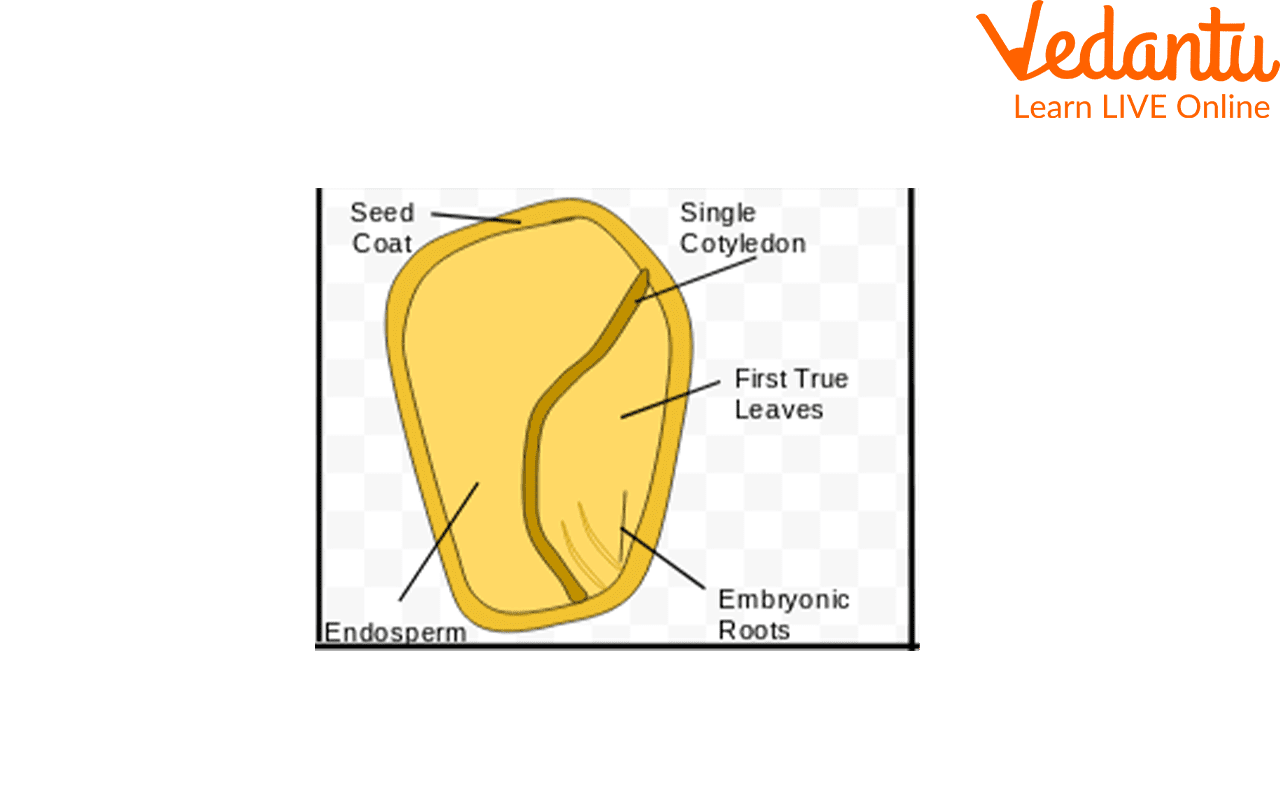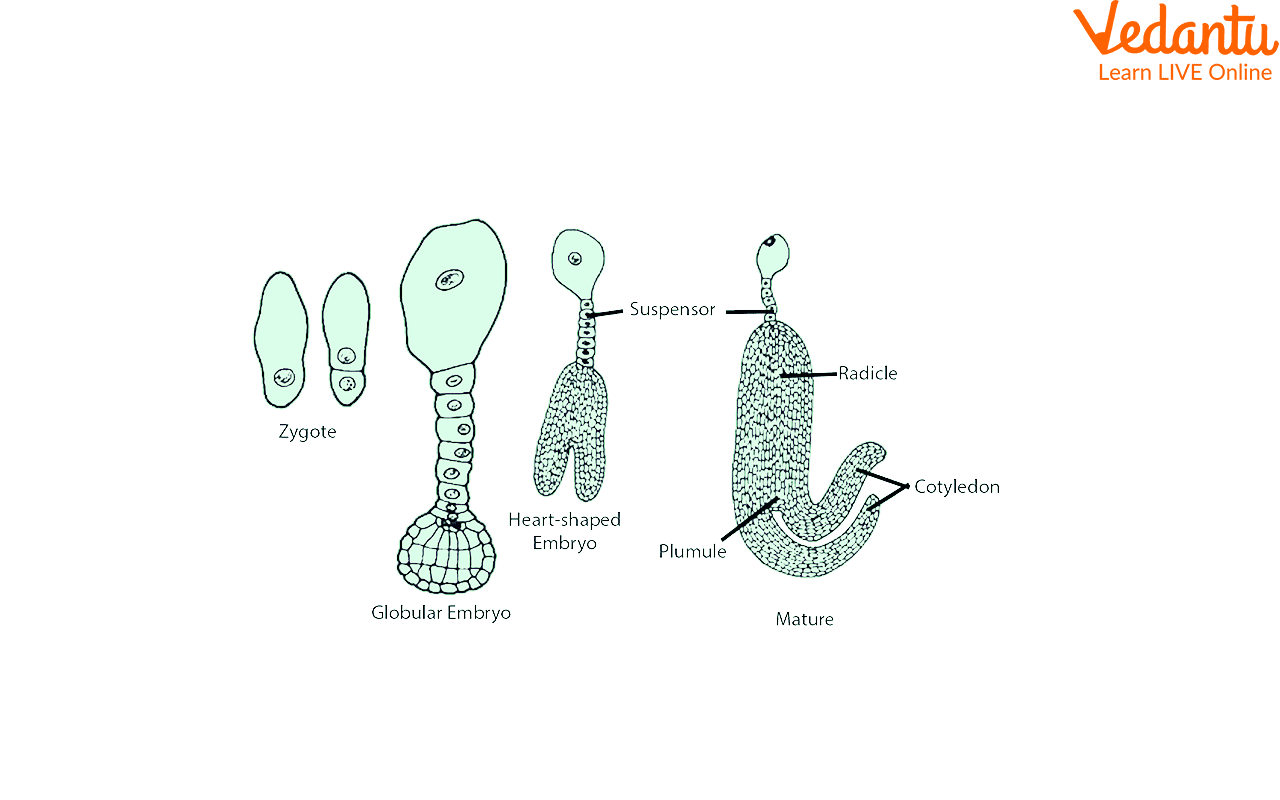In this article, we are going to study the dicot embryo and its structure of the dicot embryo. We will also learn about the development of the dicot embryo and the comparison between monocot and dicot embryos. After reading this article, readers can tell:
What is an embryo?
Comparison between monocot and dicot embryo
Development of embryo
What Are the Main Parts and Functions of the Dicot Embryo?
The dicot embryo is a crucial stage in the life cycle of dicotyledonous plants, setting the groundwork for seedling development. Understanding the structure and evolution of dicot embryos helps students grasp vital plant biology concepts. This topic explores the definition, development stages, and key features of dicot embryos with relatable examples and detailed explanations designed for CBSE class 12 and competitive exams.
Dicot Embryo Definition and Explanation
Dicot embryo refers to the young, multicellular organism present inside seeds of dicotyledonous plants. It forms after the fertilization of a male and female gamete in flowering plants and is characterized by having two cotyledons or seed leaves. These cotyledons often serve as food storage, supporting the early growth of the plant after seed germination.
- Dicot embryo definition: The developing plant inside a dicot seed, identified by two cotyledons and an embryonic axis.
- Seen in most flowering plants, especially broad-leaved species like beans, pea, and oak.
- Embryonic leaves (cotyledons) store nutrients used during the germination process.
Dicot embryos are distinct from monocot embryos, which have just one cotyledon. The differences begin to appear as the embryo develops, impacting seedling structure and classification. For more on classification, see Classification of Plants.
Structure of Dicot Embryo
A well-developed dicot embryo contains several specialized parts that help the seedling establish itself after germination. Understanding their arrangement helps clarify the functions and the process of plant growth.

- Cotyledons: Two fleshy, food-storing seed leaves. They often make up the major mass of the embryo and supply energy during germination.
- Embryonal Axis: The central stalk connecting the cotyledons, from which future plant organs grow.
- Plumule: The embryonic shoot; it forms the stem and leaves of the new plant.
- Radicle: The embryonic root; develops into the main root system.
- Hypocotyl: The region below the cotyledons but above the root; forms part of the stem and root transition zone.
- Epicotyl: The region above the cotyledons, which gives rise to leaves and the upper stem.
In mature dicot seeds, the cotyledons often dominate and act as energy reserves. The external covering of the seed, composed of the testa and tegmen, protects the embryo. The Parts of a Seed page further explores seed structure.
Development of Dicot Embryo (Embryogenesis)
The formation of a dicot embryo from a fertilized zygote is called embryogenesis. This process consists of highly organized cell divisions and tissue patterning, which establish the plant's basic body plan. The development of the dicot embryo typically occurs in several stages:

- Proembryo Stage: The zygote divides to form two cells—apical (forms embryo) and basal (forms suspensor).
- Globular Stage: Subsequent cell divisions produce a spherical mass called the globular embryo. The essential tissue layers begin to form.
- Heart-shaped Stage: The sides of the embryo enlarge, and early cotyledons appear, resulting in a heart-like shape. Bilateral symmetry sets in.
- Torpedo Stage: The embryo elongates as the cotyledons and main axis grow longer.
- Maturation Stage: The embryo loses water, becomes dormant, and the seed prepares for dispersal.
During embryogenesis, the suspensor pushes the developing embryo into nourishing endosperm tissue. As the seed matures, the endosperm is often absorbed by the cotyledons, especially in dicots, leaving little or no endosperm at germination. Learn more about Reproduction in Plants to understand fertilization and seed development.
Examples of Dicot Embryos
Dicot embryos are found in numerous plants that are important in agriculture, food security, and the environment. Some classic dicot embryo examples include:
- Peanut (Arachis hypogaea)
- Pea (Pisum sativum)
- Almond (Prunus dulcis)
- Cashew (Anacardium occidentale)
- Tomato (Solanum lycopersicum)
- Oak (Quercus)
These species exhibit the typical two-cotyledon structure in their seeds, which is essential for the early nourishment of the seedling. The dicot embryo is thus foundational to staple crops and key ecological species worldwide. Check Bean Plant and Pea Plant for practical insights.
Key Differences: Dicot Embryo vs Monocot Embryo
One of the most fundamental classifications in angiosperms is the distinction between monocots and dicots. The main differences between their embryos are summarized below.
| Feature | Dicot Embryo | Monocot Embryo |
|---|---|---|
| Number of Cotyledons | Two cotyledons | One cotyledon (scutellum) |
| Cotyledon Appearance | Usually thick, not leaf-like | Thin, often resembles a leaf |
| Plumule Position | Distal (at top of axis) | Lateral (to one side) |
| Protective Sheaths | Absent | Present (coleoptile & coleorhiza) |
The dicot embryo sets the pattern for branching root and shoot systems. Monocots, on the other hand, develop differently, impacting their leaf, flower, and seed characteristics. This classification is also useful in plant identification and crop management. For a deeper understanding, explore monocot and dicot stem differences and seed structures.
Importance and Key Features of Dicot Embryos
Dicot embryos play a central role in agriculture and natural ecosystems. Their unique development and structure determine the vigor of germinating seeds and ultimately the success of crops and wild plants.
- Seed reserves in cotyledons support the plant during early growth, essential for crops like beans and peanuts.
- Diversity of forms contributes to plant adaptation and evolution.
- Used illustratively in biology textbooks and classroom experiments for plant development.
- Vital for understanding plant breeding, biotechnology, and sustainable farming.
The study of dicot embryos also reveals evolutionary relationships among angiosperms, supporting research in life science, crop improvement, and environmental sustainability. They are also referenced in biotechnology and pharmaceutical research. More about the role of plant parts and nutrients in growth can be found on this resource.
Dicot Embryo: Questions and Applications
To apply knowledge about the dicot embryo, try answering these sample questions and exploring real-world scenarios:
- Which part of the dicot embryo gives rise to the root system?
- How do dicot embryos support early seedling development?
- Give two examples of crop plants with a dicot embryo.
- What happens to the endosperm in most mature dicot seeds?
Such questions appear in CBSE class 12 and entrance exams like NEET, where understanding dicot embryo concepts enhances biology scores. For more practice, check Parts of a Seed and seed embryonic development resources.
Interesting Facts About Dicot Embryos
Dicot embryos are connected with many fun and fascinating plant facts:
- Peanuts, beans, and sunflowers all start life as dicot embryos.
- The double coconut has the world’s largest seed—with a huge dicot embryo inside!
- Tomatoes and peas are common kitchen examples to observe dicot germination at home.
- Most trees in parks and forests (e.g., oak, maple) sprout from dicot seeds.
Experiments using dicot seeds are easy classroom activities, making the dicot embryo a foundational topic for both basic and advanced plant biology learning.
Page Summary
The dicot embryo is at the heart of angiosperm development, enabling plants to reproduce, adapt, and thrive across ecosystems. By mastering dicot embryo structure, development, and differences from monocots, students build a strong foundation in plant science for academic success and real-world application, especially in agriculture and environmental studies. For further learning, explore more biology concepts with Vedantu.


FAQs on Dicot Embryo: Definition, Structure, and Key Stages
1. What is a dicot embryo?
Dicot embryos are structures found within the seeds of dicotyledonous plants that contain two cotyledons. Key features of a dicot embryo include:
- Two cotyledons (seed leaves) storing nutrients
- Radicle (embryonic root)
- Plumule (embryonic shoot)
- Hypocotyl (region below cotyledons)
- Epicotyl (region above cotyledons)
2. What are the main parts of a dicot embryo?
A typical dicot embryo consists of distinct parts essential for germination and growth:
- Cotyledons (two seed leaves)
- Radicle (embryonic root)
- Plumule (embryonic shoot)
- Hypocotyl (stem below cotyledons)
- Epicotyl (stem above cotyledons)
3. Explain the functions of cotyledons in dicot embryos.
Cotyledons in dicot embryos mainly act as food reservoirs for the developing seedling. Their functions include:
- Storing and supplying starch, proteins, and nutrients to the embryo
- Absorbing nutrients from endosperm (if present)
- Sometimes performing photosynthesis after germination
4. Differentiate between dicot and monocot embryos.
Dicot and monocot embryos differ mainly in the number of cotyledons and structure:
- Dicot embryos: Have two cotyledons, large and fleshy
- Monocot embryos: Have one cotyledon (called scutellum in grasses)
- Dicots show distinct hypocotyl and epicotyl, monocots have only one main cotyledon
- Arrangement of root and shoot differs in both types
5. What is the role of radicle and plumule in a dicot embryo?
In a dicot embryo, the radicle and plumule are essential for initial plant development:
- Radicle develops into the root system for water and nutrient absorption
- Plumule gives rise to the shoot system, forming the stem and leaves
6. Describe the structure of a dicot embryo with a diagram.
A dicot embryo typically consists of:
- Two large cotyledons
- Radicle (lower tip for root formation)
- Plumule (upper tip for shoot formation)
- Hypocotyl (main axis below cotyledons)
- Epicotyl (portion above cotyledons)
7. Where is the embryo located in a dicot seed?
The embryo in a dicot seed is located inside the seed coat, surrounded or covered by two cotyledons. It includes:
- The cotyledons forming main bulk
- Radicle (towards the micropyle)
- Plumule (opposite pole)
8. What is the significance of dicot embryos in plant reproduction?
Dicot embryos ensure successful plant reproduction by establishing new seedlings. Their significance includes:
- Initiating root and shoot systems after seed germination
- Storing and supplying nutrients for initial growth
- Being vital for genetic transfer from one generation to another
9. Name examples of dicot seeds containing dicot embryos.
Common examples of dicot seeds (with dicot embryos) include:
- Pea (Pisum sativum)
- Bean (Phaseolus)
- Gram (Cicer arietinum)
- Mustard (Brassica)
- Groundnut (Arachis hypogea)
10. Write any two differences between cotyledons and true leaves in dicot plants.
Cotyledons differ from true leaves in several aspects:
- Cotyledons are present within the seed as seed leaves, while true leaves develop later
- Cotyledons store nutrients and support germination, whereas true leaves perform photosynthesis after sprouting
In this article, we are going to study the dicot embryo and its structure of the dicot embryo. We will also learn about the development of the dicot embryo and the comparison between monocot and dicot embryos. After reading this article, readers can tell:
What is an embryo?
Comparison between monocot and dicot embryo
Development of embryo










